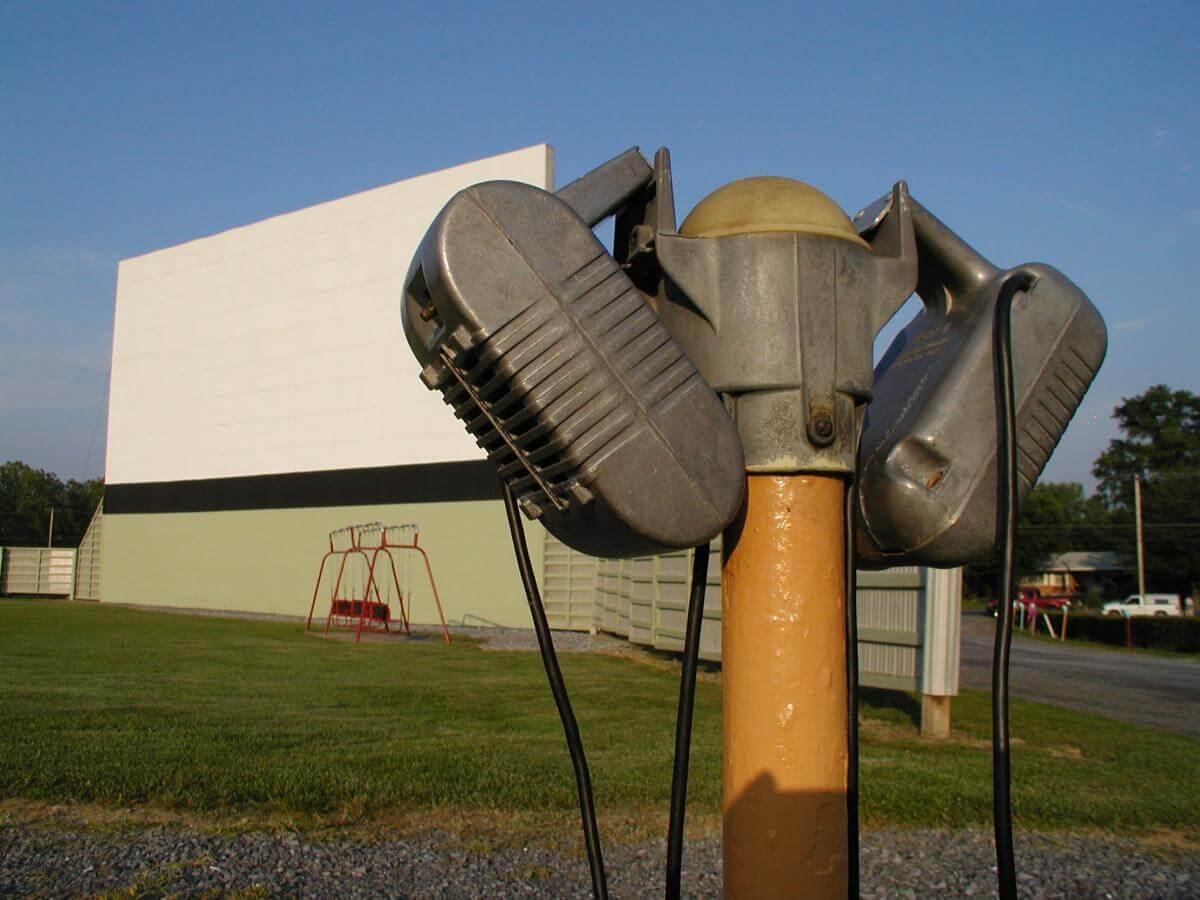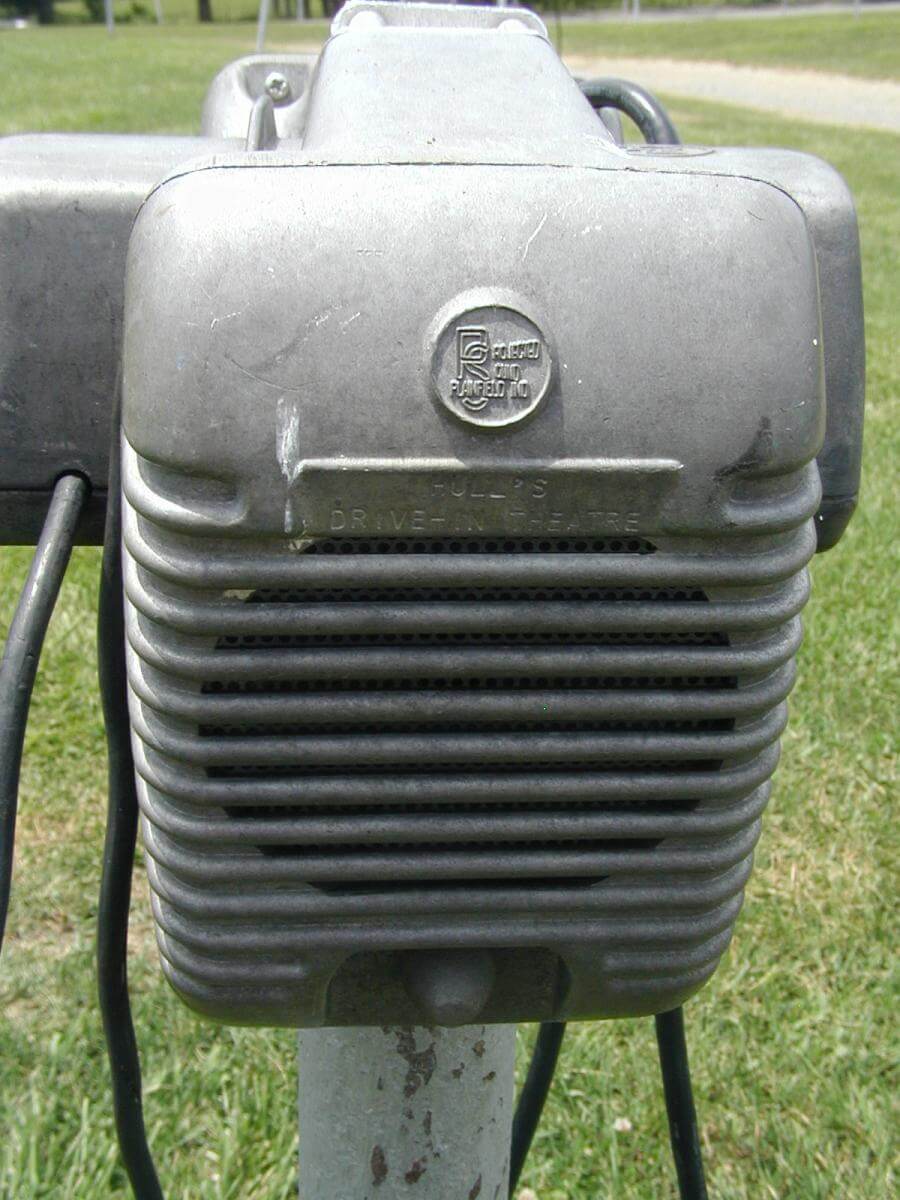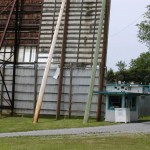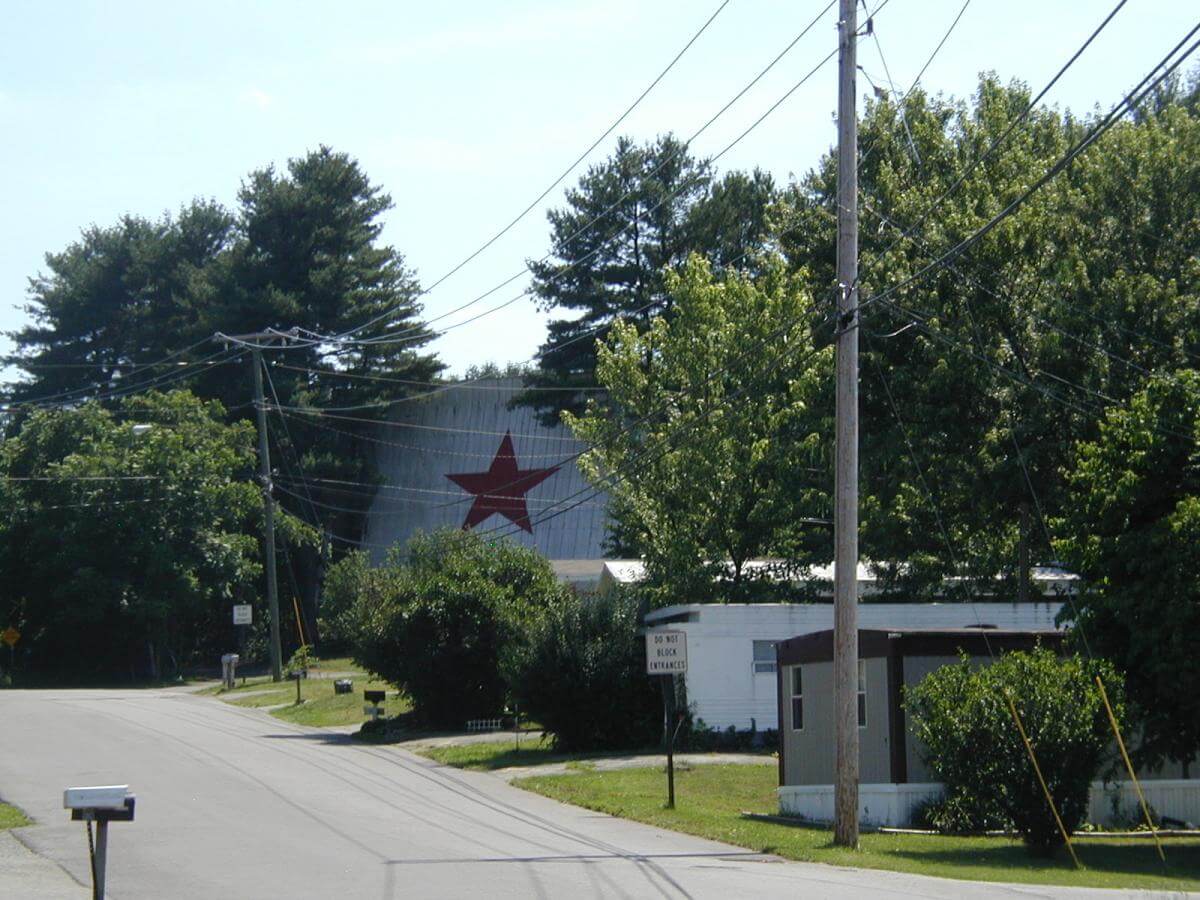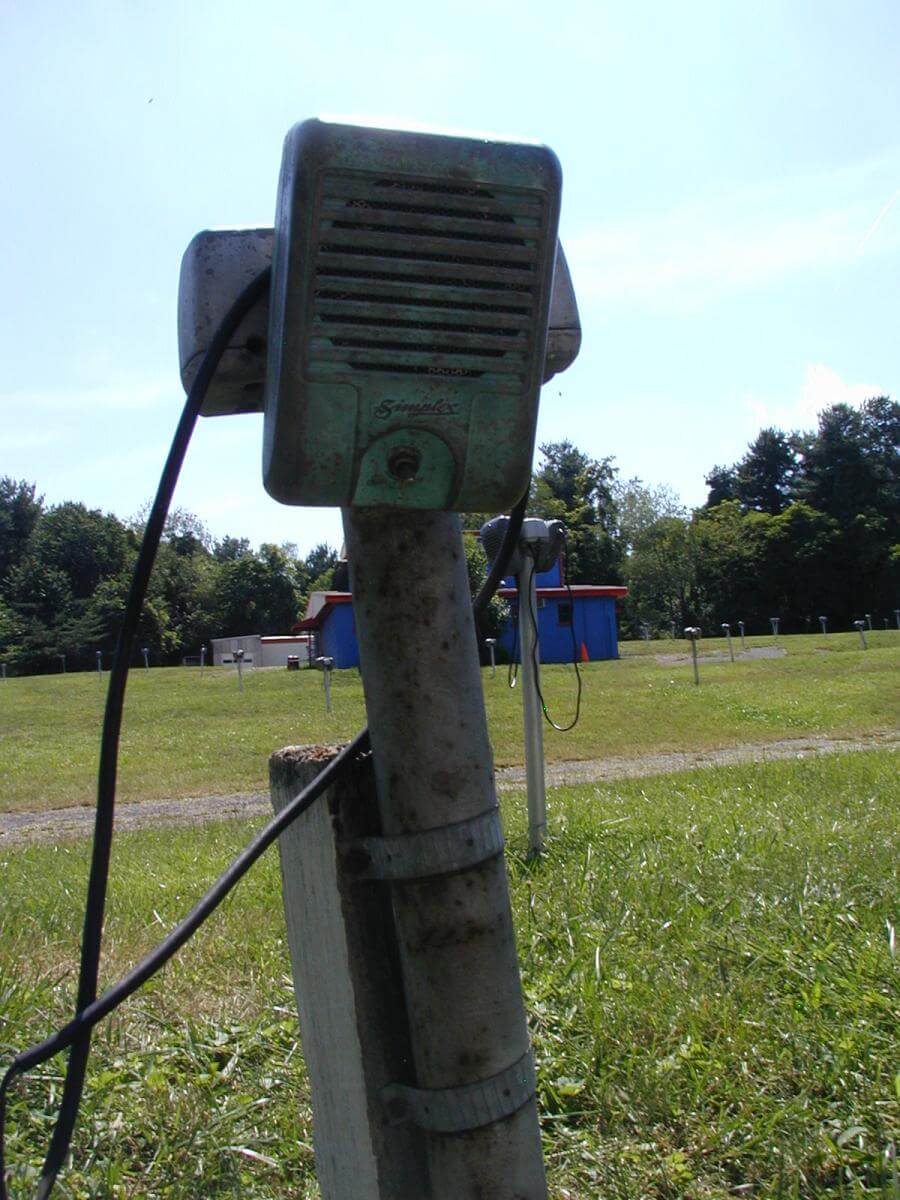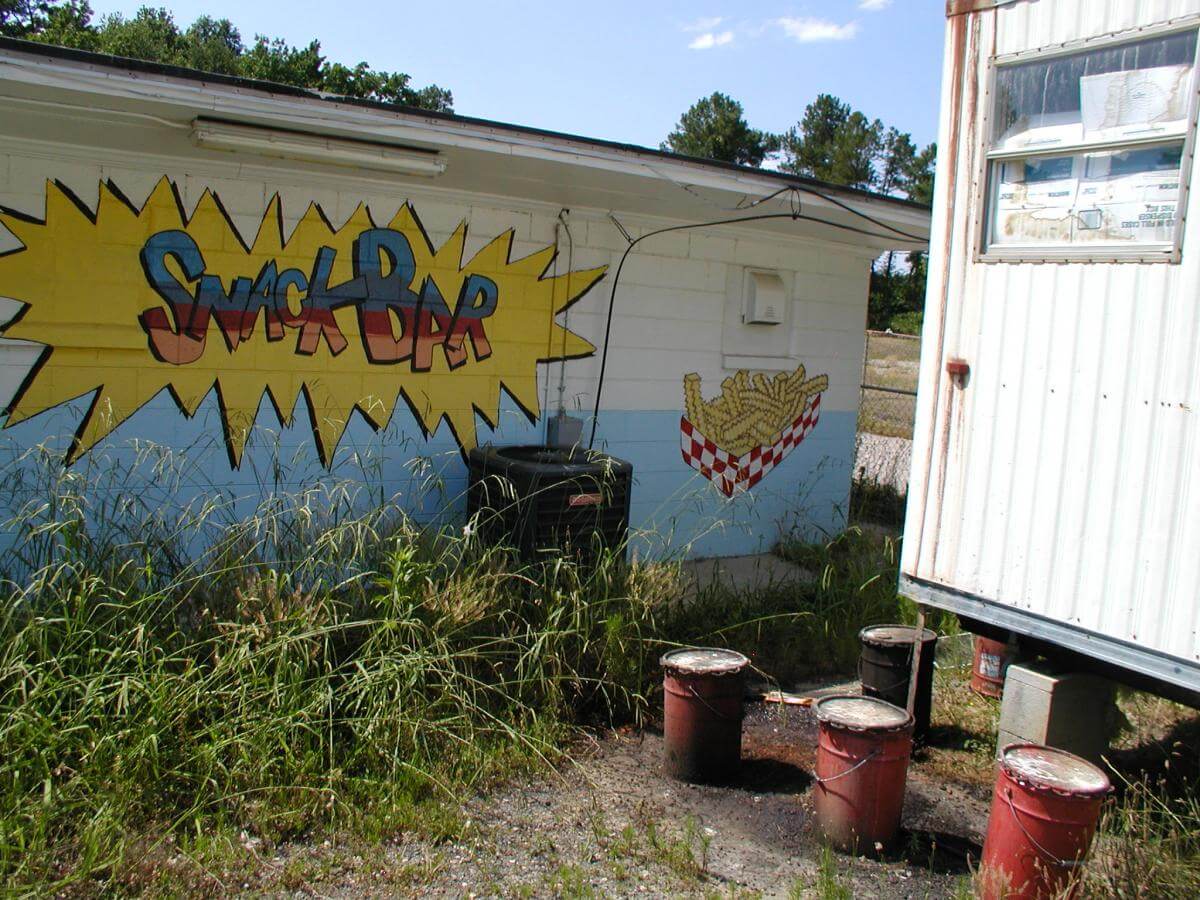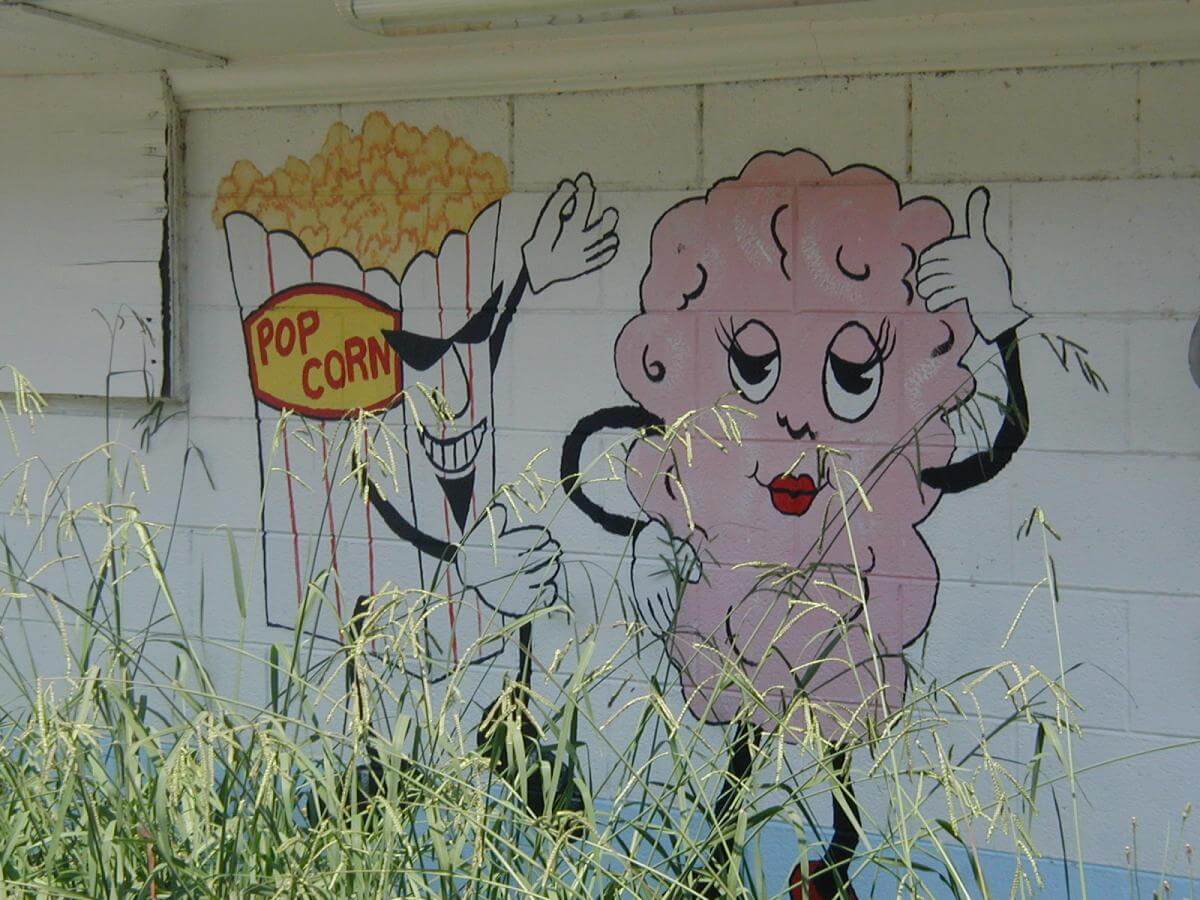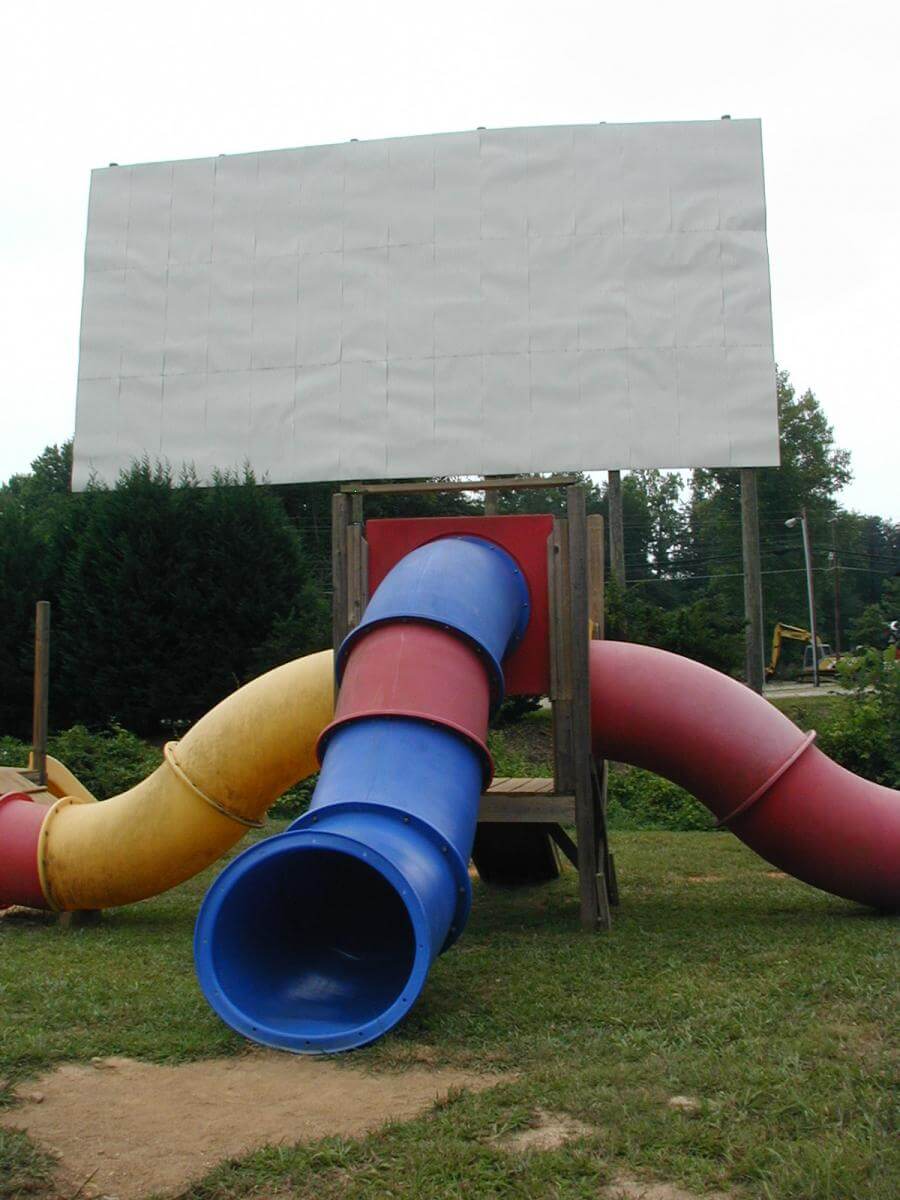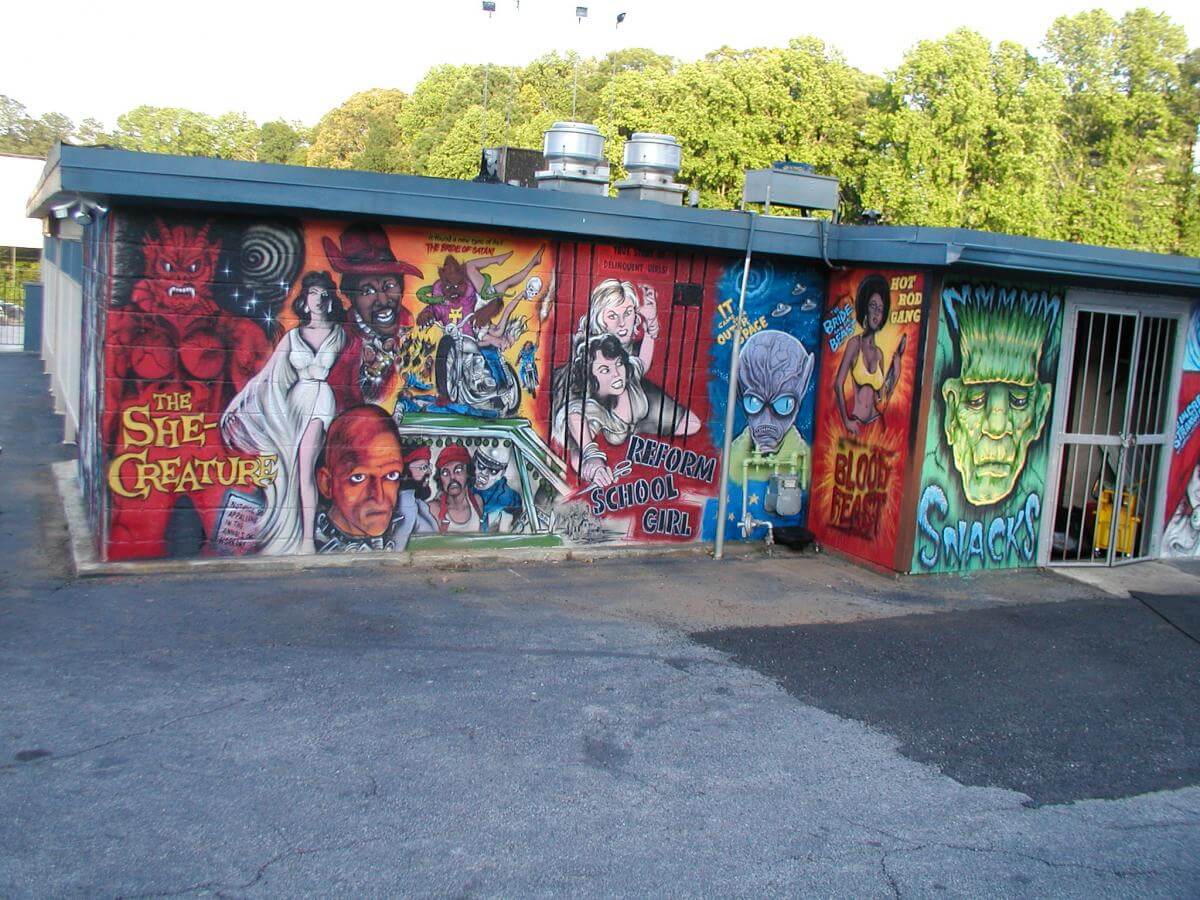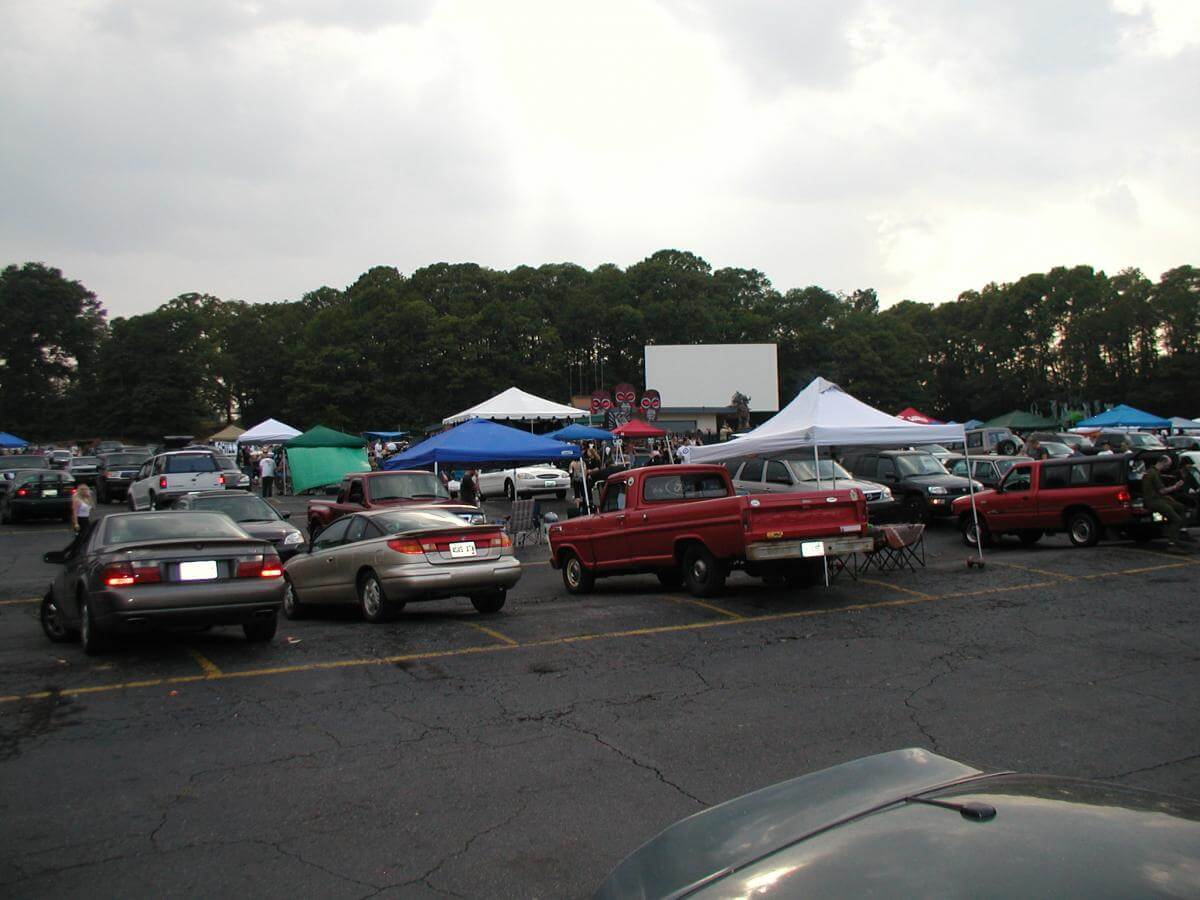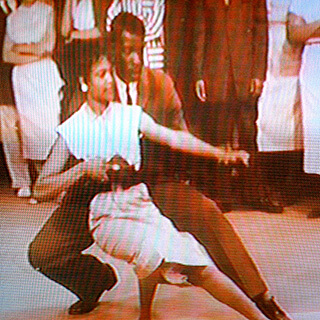Overview
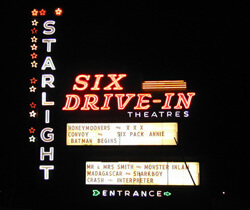 |
| Paul Johnson, Starlight Six marquee, Atlanta, Georgia, 2005. |
In June 2008, Robin Conner and Paul Johnson drove from Atlanta, Georgia, to northern Virginia, exploring and documenting drive-in theaters. They discovered a range of outdoor theaters struggling to stay commercially viable. While two were defunct, one was revitalized through the creation of a non-profit. Many theaters were even thriving through well-designed appeal to audiences of hipsters, families, and moviegoers looking to consume nostalgia at the drive-in. In this photo essay, Conner and Johnson offer a brief history of drive-in theaters and illustrate their diversity across contemporary southern rural, urban, and suburban spaces.
| Cars lined up on US Route 11, waiting to enter. Family Drive-In, Stephens City, VA, 2008. |
Introduction
2008 marked the seventy-fifth anniversary of the drive-in theater. In 1932, Richard Hollingshead, an auto parts sales manager, began to experiment with sound, car angle, and weather conditions for showing movies in his Riverton, New Jersey, driveway. The following year, Hollingshead obtained a patent for his drive-in theater plan and opened the Automobile Movie Theater (later the Camden Drive-In), with a capacity of four hundred cars, in neighboring Pennsauken. On opening night, May 16, 1933, the theater featured a second-run film, Wives Beware. The novelty of the experience, "Sit in your car, see and hear movies," may have surpassed the quality of the movies themselves, for Hollingshead and his partners struggled to obtain first-run films from distributors. Hollingshead's drive-in, where patrons "could dress as they please, smoke, talk, and eat supper at the same time" lasted three years.1"Drive-in theater," Wikipedia, http://en.wikipedia.org/wiki/Drive-in_theater; Douglas Gomery, Shared Pleasures: A History of Movie Presentation in the United States (Madison: University of Wisconsin Press, 1992), 91. William Robert Bruce Lonnee, "Preserving the American Drive-In Theater," (M.H.P. thesis, University of Georgia, 1999), 11-19. Hollingshead's difficulty in securing first-run films continued to be a common complaint of drive-in operators.
Hollingshead's drive-in established some basic parameters for subsequent theaters. In addition to technical requirements and internal spatial organization, Hollingshead's theater set a precedent for geographic location. Like the Automobile Movie Theater, located just outside Camden and just over the Delaware River from Philadelphia, subsequent drive-ins were constructed on large tracts of land on the outskirts of residential and commercial development. As Bruce Lonnee, a senior development planner for Athens/Clarke County, Georgia, points out, drive-in theaters were designed "to accommodate the automobile first and the customer second," and were usually located with access to major transportation routes. Drive-ins predated shopping malls and suburban subdivisions, but their spatial organization "typif[ies] the features of all suburban commercial development." Indeed, many drive-in theaters were ultimately leveled to make way for shopping malls or residential developments.2Lonnee, 3-4.
During the Depression few people were willing to spring for the price of tickets, and drive-ins slowly appeared on the outskirts of other urban areas, such as Galveston, Texas, Los Angeles, California, and Allentown, Pennsylvania. Gasoline rationing and rubber shortages accompanied the war years, further reducing patronage. By 1945, barely one hundred drive-ins existed in the United States.3Ibid., 28, 30. Douglas Gomery contends that only twenty-five drive-in theaters existed at the end of World War II, but this figure seems unusually low.
The postwar years witnessed an astounding upswing in drive-in popularity. By 1950, over two thousand drive-in theaters were in operation, and by 1956, more than four thousand. According to one estimate, "the public [spent] more at drive-ins. . . than at live theatre, opera, and professional and college football combined."4Gomery, 92. The drive-in's sudden popularity was due in large part to the postwar baby boom. Drive-in theaters, which offered affordable, family entertainment, catered particularly to young suburbanites with children. Most theaters boasted playgrounds; some offered miniature golf, pony rides, and fireworks exhibitions. Drive-ins appealed to the emerging teen culture, as couples sought the privacy of darkened cars.5"Drive-in theater," Wikipedia; "Interactive Statistics," Drive-ins.com, http://www.drive-ins.com/stats.htm.
The drive-in's popularity was short-lived. By the 1960s, their numbers began to decline. In the 1970s, many fell victim to suburbanization. Land on which theaters stood became more valuable for commercial development. Theaters resorted to screening exploitation films and adult-only fare. In the 1980s, the advent of cable television and the expanding video rental market brought the drive-in industry to its knees. At the beginning of the decade, there were nearly 2,500 active theaters, but by 1989, less than one thousand remained. The numbers continued to decline throughout the 1990s; by century's end, fewer than 450 theaters survived.6"Interactive Statistics."
In the 2000s, the number of theaters stabilized at around four hundred, but their geographical distribution shifted. California, with its rapidly expanding suburbs, lost seventeen theaters — nearly half its 1998 total — in the subsequent ten years. Tennessee, Texas, and Alabama added theaters as part of a growing interest not just in maintaining existing theaters, but in constructing new ones.7"Drive-in Theater Search," Drive-ins.com, http://drive-ins.com/srchdest.htm?name=&city=&code=al&status_op=open&search.x=13&search.y=12. Six of Alabama's ten drive-ins opened since 1996.8Calvin R. Trice, "Couple seek to build drive-in theater; They're scouting a suitable location and would like to open by next spring," Richmond Times-Dispatch, 4 July 2008, B1; Justin Faulconer, "Drive-in and Diner coming this fall in Moneta," The News & Advance [Lynchburg, VA], 6 August 2008; Marcia Langhenry, "Field of drive-in dreams crops up in Alpharetta; Movie costs, nostalgia spark idea," Atlanta Journal-Constitution, 15 January 2004, IJH. New theaters are planned for Virginia and possibly Atlanta's northernmost suburbs.9Faulconer, "Drive-In and Diner."
| Screen of Starlite Drive-In with Starlite Mobile Home Park in the foreground. Christiansburg, VA, 2008. |
Proponents of drive-in theaters cite a nostalgia factor: a desire for "family-oriented" entertainment. Drive-ins owe much of their recent resurgence to the "retro" aesthetic and perhaps to middle-class, white Americans' search for some imagined, idyllic past and place. In many cases, this past is located — like the hey-day of drive-ins — in the 1950s. Drive-in owners, many of them baby boomers, have tapped into this nostalgia. Theaters tout G- and PG-rated films and highlight their "family-friendly" atmosphere. A theater under construction in Moneta, Virginia, near the resort community of Smith Mountain Lake, explicitly claims this heritage and will be named the Mayberry Drive-In, after the fictional town in The Andy Griffith Show. The Mayberry will include a 1950s-style diner, and movies with PG- or PG-13 ratings.10For a discussion of family life in the 1950s, see Elaine Tyler May, Homeward Bound: American Families in the Cold War Era (New York: Basic Books, 1988); and Stephanie Koontz, The Way We Never Were: American Families and the Nostalgia Trap (New York: Basic Books, 1992).
The reinvention of the drive-in theater as an imagined space of a supposedly more moral, wholesome era obscures and ignores the tensions and repressions of that period, tensions which shaped drive-ins and other forms of popular entertainment.11Gomery, 156-158. On temporal and spatial segregation, see also Robert R. Weyeneth, "The Architecture of Racial Segregation: The Challenges of Preserving the Problematical Past," The Public Historian 27 (2005): 11-44. Contemporary hipsters and rockabilly fans also claim drive-in nostalgia, through a past evocative of James Dean, Elvis Presley, and Marlon Brando — icons of 1950s teenage rebellion. Drive-ins first achieved reputations as "passion pits" where unsupervised teens inaugurated the sexual revolution.
Drive-in nostalgia does not acknowledge the white racism that characterized the drive-in's glory years. Like most other public establishments in the South prior to the 1960s, indoor movie theaters were legally segregated. As Douglas Gomery explains, de facto racial segregation in movie theaters was common outside the South as well, but was dictated more by "residential patterns of use." Some southern locales contained black-only movie houses, but these were often poorly equipped and maintained, and usually only screened first-run films after white theaters had shown them. Other forms of segregation included designated viewing times for African-Americans, usually after movie houses had closed for whites; restricted balcony seating areas; and separate entrances, concessions, and toilet facilities for whites and blacks.12Weyeneth, 21.
Despite many studies of discrimination in other entertainment venues, scholarship on segregation at the drive-in is almost nonexistent. There are indications that such segregation may have been the norm in Dixie. Robert Weyeneth notes that the "general pattern [of segregation] was exclusion."13Don Sanders and Susan Sanders, The American Drive-In Movie Theatre (Osceola, WI: Motorbooks International, 1997), 55; "Lock Haven Drive-in," Drive-In Theaters of the Mid-Atlantic, http://www.driveins.org/va-roanoke-lochhaven.htm. The Booker T. closed without notice in April 1953 and reopened shortly thereafter as a white-only theater. While venues like the Olympic Theater in Los Angeles served patrons of all races, black-only drive-ins such as the Booker T. in Roanoke, Virginia, or the Star-Lite in Dallas, Texas, appeared below the Mason-Dixon Line.14Weyeneth, 21. The Sunset Drive-In in Hamburg, Arkansas had similarly segregated facilities. Sanders and Sanders, 55. Drive-ins that admitted both races sometimes attempted to segregate through partitioning. When Richmond, Virginia's Bellwood Theater opened in 1948, it contained "segregated motor entrances defined by a wall in between. African Americans entered the drive-in from the back. . . and parked in the walled-off northeastern corner of the theater lot. Separate concession stands and restrooms were provided in the vicinity."15Weyeneth, 21.
The sit-ins and civil rights legislation of the early 1960s that ultimately brought desegregation to indoor movie theaters may have had the same effect on outdoor theaters. However, by the end of the 1960s, drive-in theaters were past their prime, and integration may have become a moot point as theaters gradually closed.
This history of segregation raises other questions: whose nostalgia is driving the new drive-in movement? What notions of "family" does the "family-oriented" marketing apply to? As many of the theaters documented in this essay demonstrate, the drive-in theater can represent an imagined past characterized by older, often unexamined, ideologies of family and community; but it can also testify to new, emerging patterns of social togetherness. Drive-in fans exhibit pride in the theaters they patronize and an awareness of the drive-ins' power as spaces of pleasure. This spirit takes a variety of forms, including contributing time and resources to revive ebbing drive-ins and sometimes pushing for their historic recognition.16Debra McCown, "Moonlite Drive-in Theater gets historic designation," Bristol Herald-Courier, 7 June 2007; idem, "Moonlite Drive-In finds a parking spot on the National Register of Historic Places," Bristol Herald-Courier, 1 September 2007. In 2007, the Moonlite theater in Abingdon, Virginia became one of three drive-in theaters nationwide to be placed on the National Register of Historic Places.
The drive-in theaters featured in this essay are located in the Valley of Virginia, the Appalachian foothills, and the eastern edge of the North Carolina piedmont. Each suggests how people in different rural and urban places relate to the drive-in: from the bustling Starlight Six in Atlanta to the defunct Starlite in Durham; the rebirth of the Tiger Drive-in and the all-but-disappeared Commerce Drive-In in northern Georgia.

Map of Featured Drive-In Theaters
Most of the theaters in this essay were visited during a one-week period in June 2008 as part of a trip from Atlanta to northern Virginia. The route extended northeast along Interstate 85 to Petersburg, Virginia, then over to Interstate 95. The return trip originated in Winchester, Virginia, and traveled through the Shenandoah Valley on Interstate 81 and US Route 11, then turned south on Interstate 77, picking up I-85 at Charlotte.
We identified possible theaters and theater sites by surveying www.drive-ins.com. The theaters we chose were close to our route, had addresses that could be located, and seemed relatively easy to find. Also their aerial views on Google Earth contained recognizable drive-in ramps. Even though there were a number of other active theaters in southwestern Virginia — including the Moonlite, the Park Place, and the Hiland — and northeastern Tennessee, time and route constraints prevented us from visiting them.
About the Authors
Robin Conner has PhD in History from Emory University. Her current research explores gender and class identities in post-Civil War western military bases. She is a Visiting Lecturer at Georgia State University.
Paul Johnson is a freelance photographer, draftsman, and drive-in enthusiast. He lives in Atlanta, Georgia.
Family Drive-In - Stephens City, Virginia
Surrounded by historic landmarks, the Family Drive-In faces US Route 11, which runs through the Shenandoah Valley. Once a Native American trail, and known as the Great Wagon Road or the Valley Turnpike to eighteenth- and nineteenth-century German and Scots-Irish emigrants who followed it southward from Pennsylvania into Virginia and the Carolinas, Route 11 served as the principal north-south thoroughfare until the construction of Interstate 81 in the 1960s. The Family Drive-In stands about a mile south of Stephens City, Virginia, a nineteenth-century transportation hub known for manufacturing Conestoga wagons, and five miles north of Middletown, Virginia, site of the pivotal Civil War Battle of Cedar Creek. General Philip Sheridan's ride south from Winchester to rally retreating Union forces passed directly over the Drive-In's grounds. Opened in 1956, and run continuously by the Dalke family, the Family Drive-In has become a recognized part of local history. In 2006, to commemorate the Drive-In's fiftieth anniversary, members of the Dalke family endowed a scholarship at nearby Lord Fairfax Community College.17 "Local family serves region for almost 100 years, and creates a lasting legacy at LFCC." Shenandoah.com Stories, 2 September 2006, http://shenandoah.com/stories/?id=7227.
The Family Drive-In remains well-maintained and well-attended. On a recent June Saturday night, patrons arrived more than half an hour before the gates opened: lines of cars on Route 11 waiting to enter stretched for nearly a quarter-mile in both directions. Bright, multicolored speaker poles partitioned the gravel parking area, and children gamboled on the grassy playground in front of the main screen while parents kept watch from nearby bench swings. A sleek Jaguar convertible parked near a 4x4 pickup with oversized tires. As one of only two drive-in theaters in relatively close proximity to Washington, D.C, the Family Drive-In draws locals as well as guests from the Northern Virginia suburbs and from West Virginia.18The other drive-in near Washington, DC is Bengie's, which is east of the District in Baltimore; Ellen McCarthy, "Half a Century Later, Nostalgia for Stephens City's Silver Screen." Washington Post, 18 July 2008, City Guide. On summer nights, parking areas for both screens — the Family Drive-In is the only remaining "twin" drive-in theater in Virginia — are often filled to capacity. Typical audiences are predominantly white and economically and age-diverse, with ages ranging from teens to young families and older couples.19On demographics in the Winchester-Frederick County area in 2000, see: http://en.wikipedia.org/wiki/Frederick_County,_Virginia#Demographics and http://en.wikipedia.org/wiki/Winchester,_Virginia#Demographics. For 2007 figures for the Winchester metro area, see http://www.bestplaces.net/city/virginia/winchester.
Perhaps due to its proximity to a large metropolitan area as well as local patronage, the Family Drive-In remains one of only nine surviving drive-ins in Virginia.
Hull's Drive-In - Lexington, Virginia
Small and well-kept, Hull's Drive-In Theater is nestled in the rolling hills along US Route 11, just north of Lexington, Virginia. Vintage speakers decorate the gravel parking lot and mark parking spots for patrons. The speakers are functional, but audio is also transmitted by the theater's FM broadcast. Bright blue restaurant tables adjoin the concession stand. A black-and-white flyer near the snack counter promotes the 75th Anniversary of Drive-Ins by offering seventy-five cent popcorn. Hull's large, white movie screen is supported by metal framework in the middle and by wooden telephone poles on the sides, which suggests that the screen may have been enlarged at some point in the past.
In 1999, Hull's was dark throughout the summer for the first time in forty-nine years. Owner, W. D. Goad, who ran an adjacent auto body shop, had purchased the theater in 1998, after the death of longtime owner Seburt Hull. Faced with high upkeep costs, Goad decided to search for a buyer who was not only willing to finance the upgrades, but who would also keep the theater "family friendly." Even though Hull's double-feature started at 9:00 pm, cars arrived as early as 5:30. As one fan explained, "We like to come early so the kids can come out and play before."20Jenny Jones, author, Pete Marovich, photographer. "Hull's Drive-In: Preserving a Piece of Americana." American Journal, Issue 9. http://hullsdrivein.com/docs/press/PDF/AmericanJournal.pdf
A commercial buyer never came. Instead in June 1999, Eric and Elise Sheffield held a public meeting with fifty concerned fans, and they agreed to form a non-profit group called "Hull's Angels" to keep the drive-in open. In the spring of 2000, the group launched a $75,000 capital campaign; by July 2000, more than six hundred donations, ranging from twenty to two hundred dollars, had poured in. The Angels purchased the business in May 2001, and successfully operate Hull's Drive-In as the United States' only non-profit, locally-owned drive-in.21Ibid.
For now, Hull's Drive-In is sustained because its audience of patrons extends well beyond the small town of Lexington to include, as described by Manager Frank Kulesza, a variety of people, "From dirt farmers and people from other parts of Virginia to tourists from Australia and Germany."22Don Harrison, "See You at the Movies." The Roanoker, July/Aug 2008. http://theroanoker.com/interests/business/see-you-at-the-movies/ Hull's Angels' members pay annual dues, encourage press coverage, and run fundraising activities. Online sites, such as Jennifer Sherer's Drive-ins.com and Drive-in Theatres of the Mid-Atlantic provide enthusiasts with descriptions and directions. Sherer's site also generates support for theaters facing high maintenance expenses and low profitability. "We've had people of all ages write to us and thank us for enabling them to tap into this online drive-in enthusiast community," says Sherer. "Ultimately we think it encourages people to go out and support their local drive-in."23Ibid.
Starlite Drive-In - Christiansburg, Virginia
The Starlite Drive-In is located in the southwestern Virginia town of Christiansburg, along the New River Valley on the western side of the Blue Ridge Mountains. Neon lights illuminate the blue-and-red ticket booth and the matching building that houses the projector, restrooms, and snackbar. The Starlite's bright colors contrast with the drive-in's residential surroundings. Two beige ranch houses sit behind the last row of parking. The screen abuts the Starlite Mobile Home Park; the large red star painted on its metal back peeks through overgrown trees at the end of a neighborhood street.
Richard and Dot Beasley opened the Starlite in 1952. At one time, the theater competed with the Hiway, the Autodrome, and the Midway in nearby Pulaski and Radford. As many as eight drive-ins operated in Roanoke, thirty-five miles north. More than fifty years later, the 250-car Starlite is the only one of these theaters still in operation and is one of only eight active drive-ins in Virginia.24Dan Kittle, "At the Starlite, the Show Goes On; As Drive-Ins Dwindled, ‘They Never Did Quit Coming Here,'" Roanoke Times, New River Valley Edition, 23 May 2002, NRV3; Donna Alvis-Banks, "Still the Good Old Days—and Nights—at the Starlite," Roanoke Times, New River Valley Edition, 4 September 1994, NRV16.
Dot met her future husband Richard while he was working as a ticket-taker at Christiansburg's now long-defunct Glen Theatre, which he co-owned along with his father and brother. The couple married, and, after selling the Glen, decided to open a drive-in. "I had a lazy streak," recalls Richard. "I thought how great it would be not to work in the wintertime." After purchasing used equipment and five acres of land, he designed and built the facility. The family's house stands on a corner of the property, as does that of their daughter Peggy, who took over ownership of the Starlite in 1985.25Brittany Davis, "Drive-In Offers Memorable Summer Nights." The Roanoke Times, 25 May, 2007.
Now in their 70s and 80s, the Beasleys have considered retirement, yet each year the Starlite draws them back: Richard resumes his position in the ticket booth while Dot dishes up the Starlite's renowned hot dogs and chili, the main attraction for some patrons.26Kittle, "At the Starlite."
Raleigh Road Outdoor Theatre - Henderson, North Carolina
Open since 1949, the Raleigh Road Outdoor Theatre, originally the Moon-Glo, is North Carolina's oldest drive-in. Ali-Baba & The Forty Thieves (1944) was the first film shown on its thirty-six by forty-eight foot screen. According to the following day's Henderson Daily Dispatch, moviegoers were "invited to smoke if they wish, dress as they please," and were encouraged to "bring your snap beans or other vegetables to prepare for the next day's meals."
In 1977, original owner Sonny Stevenson sold the Moon-Glo to the Lyle family, who renamed the theater after its location. Ownership changed hands again in 2004, when the theater became the first drive-in sold on eBay, for $22,000, to Jim and Megan Kopp.27Matt Ehlers, "Out at the drive-in," The News & Observer. [Raleigh-Durham, NC], 28 March 2008. http://www.socaldims.com/apps/blog/show/87294-out-at-the-drive-in Jim Kopp's passion for drive-ins led the couple to spend $300,000 on updates and renovations.
[Jim] and Megan made the 200-mile trip from Virginia to check it out before placing their final bid. The place was overgrown with weeds, and Megan thought he was crazy for even considering the purchase. Jim wouldn't be deterred.
In the theater's storage room, the Kopps found old speakers, movie posters, and unreturned films, including the 1967 sexploitation feature, Shanty Tramp, from a period when many drive-ins showed late-night adult movies.28Ibid. Ironically, "Shanty Tramp" is set in the rural South and features the story of a white girl who falls for a black boy, despite the sexual advances of a southern Evangelical preacher.
The Koops have worked to make the renovated Raleigh Road a premier spot for family entertainment. "Family Fun under the Stars" greets visitors from the roadside, one of many signs throughout the grounds. Other notices tell patrons where to park, where to tune their radios, how children should play on the plastic playground, and what is and isn't allowed in Raleigh Road — dogs, yes; outside food, no.
There were once two hundred drive-ins in North Carolina, but by 2008, only seven remained in operation. Undeterred, the Kopps, according to their website, hope to bring their theater into the "digital age" by updating their projectors and speakers while keeping the Raleigh Road affordable. Current admission prices are five dollars for adults and two dollars for children.
Starlite Drive-In - Durham, North Carolina
The Starlite Drive-In stands in a residential area northeast of Durham, less than half a mile from Interstate 85. Grass and weeds slowly reclaim the sandy gravel parking area; a fifteen-foot-high mound of used tires is heaped against the back fence. Speaker poles and junction boxes remain, but the speakers are long gone. Brightly-painted murals of anthropomorphized concession treats — dancing hot dogs and burgers, a lecherous popcorn bucket, and smiling condiments — decorate the concrete-block snackbar and projection booth. The paint appears fresh, but tall weeds and boarded windows suggest no activity. Inside, clutters of spare mechanical parts, video rental boxes, sleeves of Coca-Cola cups, and film canisters hint at an abrupt abandonment. Even much of the projector remains.
Most drive-in theaters pay significant fees — up to eighty to ninety percent of the box office take — to screen films. Concession sales and auxiliary business ventures are vital in keeping the gates open and screens lit. Like many other drive-in theaters, the Starlite hosted a Saturday flea market. In addition, as the Walther, Colt, and Ruger window decals on the projection booth testify, late proprietor Robert "Bob" Groves opened a gun shop and video club shortly after he acquired the theater in 1987.29Anne Krishnan, "Movies Under the Stars; Starlite Drive-In remains Durham institution," Herald-Sun [Durham, NC], 10 July 2004, A1.
The last Durham-area drive-in still standing, the Starlite's future is uncertain. In 1996, Hurricane Fran caused thousands of dollars in property damage. In 2004, an overheated riding mower sparked a fire that destroyed the screen with resulting damages between $35,000 and $70,000. The insurance company had deemed the screen too old to insure.30Hunter Lewis, "End of an Era?; Starlite Drive-In's screen goes up in smoke; owner says he'll rebuild, possibly within 30 days," Herald-Sun [Durham, NC], 23 August 2004, B1; Eric Olson, "Probe traces drive-in fire to hot mower; Workers start collection to rebuild screen," Herald-Sun [Durham, NC], 24 August 2004, C1.
Groves, who lived in a mobile home adjacent to the theater, vowed to rebuild. Members of the local community formed the Save Our Starlite Foundation. A grading contractor provided heavy equipment for clean-up; workers donated their labor. Area businesses set up collection jars. Avon representatives contributed profits, and a Harvest Dance on the drive-in's grounds raised several thousand dollars.31 "Briefs," Herald-Sun [Durham, NC], 27 August 2004, B5; Jim Shamp, "Starlite Hopes Bright; Wish list sparks renewal drive for fire-ravaged drive-in," Herald-Sun [Durham, NC], 3 September 2004, C1; John McCann, "Help Among the Ashes," Herald-Sun [Durham, NC], 12 September 2004, C1; Susan Broili, "Benefit dance hopes to bolster drive-in's rebuilding; Starlite's movie screen may be rebuilt next year," Herald-Sun [Durham, NC], D9; Ben Evans, "Starlite's screen could soon flicker anew," Herald-Sun [Durham, NC], 30 November 2004, A1. The Starlite reopened in August 2005, a year after the fire. On opening night, a line of vehicles extended onto I-85 and more than fifty cars were turned away.
The Starlite's resurrection was brief, however, as Bob Groves died suddenly from heart failure in March 2007. The drive-in has been closed ever since.32"Starlite Drive In owner dies at age of 55; Groves rebuilt theater after fire destroyed its screen," Herald-Sun [Durham, NC], 13 March 2007, C3; [obit]. Some community residents have expressed wistful desires to raise funds to purchase the property or to seek its designation as a historic site, but with the theater and adjoining land parcels (also owned by Groves) appraised at over $1.8 million and a Super Wal-Mart under construction on a nearby site, further development seems unlikely. Even if community efforts to preserve the Starlite do not succeed, it is clear local residents have taken a keen interest in the theater's welfare. As we prepared to leave the vacant theater, a Durham County Sheriff's Deputy — summoned by neighboring residents — arrived to make sure we were not vandals or thieves.
Bessemer City Kings Mountain Drive-In - Bessemer City, North Carolina
There are four active drive-in theaters within a forty-mile radius of Charlotte, North Carolina: the Belmont, the Sunset, the Bessemer City Kings Mountain to the south, and the Badin Road to the east. Located on North Carolina State Route 161 about two miles north of Interstate 85, the Bessemer City Kings Mountain Drive-In is in poor physical condition. Paint peels from the ticket booth, and one side of the roof seems haphazardly repaired. A "7" made from black electrical tape announces the price of admission has been reduced by a dollar per car — this is the only drive-in we visited that charged by the carload. There is no playground in this austere space. Strips of parched grass run between gray gravel driveways. Heavily rusted speaker poles tilt awkwardly over mowed grass. The difficulty in maintaining functional drive-in speakers was also apparent — speaker connections were patched with electrical tape, and the speakers themselves often bear the names of other drive-in theaters. The screen itself, composed of white rectangular panels, had begun to warp from weather exposure. Hot summer sun filtered through cracks between the panels.
Rick Stinnett, owner of the Bessemer City Kings Mountain, lives on-site in an adjacent white house. His parents started the Bessemer City theater, and he took over the family business in 1995 — ten years after he acquired the Sunset Drive-In. Like the Starlite in Durham, and many other individually-owned drive-ins with aging proprietors, Bessemer City Kings Mountain faces an uncertain future.33Drew Brooks, "Drive On In: Outdoor drive-ins may be dying, but two local theaters hang on," Shelby Star [Shelby, NC], 11 October 2007.
Tiger Drive-In - Tiger, Georgia
In 2004, the Tiger Drive-In marked its fiftieth anniversary by reopening. Once the "heartbeat" of Tiger, Georgia, a small mountain community on Old Highway 441, three miles south of Clayton, the drive-in had been shuttered since the mid-1980s. Daylight Savings Time, which forced theater owners to push back movie start times, sapped attendance by shift workers. The video rental boom of the 1980s heralded the theater's collapse. An offer to build a cemetery on the drive-in's terraced slopes inspired Sherryl Wilson Major, daughter of one of the original owners, and her husband Tom, to bring the theater back to life.34"History," Tiger Drive-In Theater, http://tigerdrivein.com/home/history/; Martha M. Ezzard, "A drive back in time; Screens at historic Tiger drive-in flicker back to life tonight," Atlanta Journal-Constitution, 10 April 2004, 1D.
The Tiger barely has space for two hundred cars, but on an early June Saturday night it fills rapidly. As showtime approaches, early arrivals are asked to shift their cars to accommodate additional vehicles. The snack bar features hotdogs and popcorn, as well as Black Angus burgers. Children play on brightly-colored swings and slides in front of the screen; "Red Rubber Ball," "The Sloop John B," and the "Ballad of the Green Berets" loop from a CD boombox broadcast over the theater’s sound system. This Saturday night is also the monthly Year One Hot Rod Night at the Tiger. Classic cars like the owner's 1957 Corvette share space with a row of "rat rod" VWs and dune buggies.
Twenty years after its initial closure, the family-owned Tiger is once again a local attraction. It occupies a central location on the strip beside the fire department, near a popular vineyard on the Georgia Wine Highway, and abutting an assisted living facility — also owned and operated by the Majors. Monday is senior night with bingo.35Ezzard. Ezzard is co-owner of the Tiger Mountain Vineyard mentioned here. Tom and Sherryl Majors sell tickets, supervise the snack bar, and try to involve their children in the operation; one son even dons a tiger suit to promote the theater during special events.
Commerce Drive-In - Commerce, Georgia
Two parallel driveways leading away from US Highway 441, just south of Commerce, Georgia, offer the only indication that the Commerce Drive-In once stood over the crest of the hill. A "for sale" sign stands on a rise to the left; a cable stretched across the entrance bars entry Paved asphalt and cropped grass give way to an undergrowth of tall weeds, briars, and young pines. Broken pavement covered with pine straw and weeds curves around the ticket booth. The booth's white paint appears crisp, but the red trim is peeling, and no glass remains in the windows. Vines, thorns, and large bushes block approach to the booth on three sides. Beyond, the brush clears to reveal the old parking lot, concession stand, and, at the far edge of the field, the remnants of a screen.
After nearly fifty years in operation, the Commerce Drive-In closed in 2001. Once, it sported three screens, but now only a few forlorn sections of plywood cling to the screen's skeletal wooden supports.36Gardner Linn, "Drive in, put it in park," The Red and Black [University of Georgia], 25 January 2001, Variety. http://www.redandblack.com/variety/drive-in-put-it-in-park/article_f83376cb-7993-520c-80ab-1110098fe456.html]. For a more detailed discussion of the layout of the Commerce Drive-In, see Lonnee, 107-115. Scrub grass and weeds cover the paved gravel lot. A few rusted speaker poles sprout here and there, but most are gone. The doors and windows of the concession stand yawn open. Inside, little remains except more peeling paint, collapsed ceiling tiles, and a row of three porcelain toilets.
The Woodall family operated the Commerce Drive-In for more than thirty years before competition from multiplexes led them to shutter the theater. Envisioning a "family-friendly entertainment complex," Joe Woodall opened a new two-screen drive-in forty miles away in rural Dewy Rose, Georgia. To compete with suburban multiplexes, Woodall installed up-to-date FM sound. A corn maze draws families and local college students in the fall; a hotel and winery are in the works.37 Ronell Smith, "Dewy Rose drive-in bucking trend," Athens Banner-Herald, 3 June 2003 [http://onlineathens.com/stories/060303/mov_20030603008.shtml]; Kyle Wehrend, "Drive-in sets up shop," The Red and Black [University of Georgia], 26 August 2002, Variety [http://www.redandblack.com/variety/drive-in-sets-up-shop/article_315c98ee-0c48-5325-b725-87c879d0c3fb.html]; Danielle Hutlas, "Mazes more than corn," The Red and Black [University of Georgia], 13 October 2005, Out and About [http://web.archive.org/web/20090113172411/http://media.www.redandblack.com/media/storage/paper871/news/2005/10/13/OutAbout/Mazes.More.Than.Corn-2570682.shtml].
In the coming months, it is likely that any physical indication of the Commerce Drive-In's existence will be wiped off the lot where it has stood for a half-century. In place of the Commerce Drive-In, commercial development will likely follow. However, the defunct and disappearing Commerce has a unique legacy in its former owner's new drive-in theater in Dewy Rose.
Starlight Six - Atlanta, Georgia
At one time, Atlanta offered the Piedmont, Thunderbird, Bankhead, Stewart, Fulton Boulevard, Bolton, and Starlight drive-ins. Now only the Starlight remains, one of seven operational Georgia drive-ins. Among southeastern cities, Atlanta, along with Tampa, Miami-Dade, and Memphis, still boasts a drive-in within city limits, something few US cities can claim.
Located in southeast Atlanta on Moreland Avenue, two miles north of Interstate 285, the Starlight Six, like many other theaters, was built decades ago on what was then the outskirts of town. As suburban development radiated, rising residential and commercial property values closed many drive-ins.38Scott Henry, "Drive-in revival: Hipsters and boomers alike rediscover the joy of watching a movie outdoors." Creative Loafing [Atlanta, GA], 26 June 2002 [http://clatl.com/atlanta/drive-in-revival/Content?oid=1237455]. The Starlight Six did not suffer this fate because its location — adjacent to the Dekalb County Landfill, a trucking company, a cemetery, housing projects, and neighborhoods plagued by criminal activity by the early 1990s — made it unattractive to developers.39Ibid.; Kathy Scruggs, "Police nab 13 in two-hour raid on vice strip; But Moreland Avenue residents hope crackdown isn't for show," Atlanta Journal and Constitution 4 August 1991, C1.
The Starlight was originally a single-screen theater when the Georgia Theater Company opened it in 1947. In 1956, the Georgia Theater Company added a second screen, and the drive-in's name was changed to the Starlight Twin to reflect the expansion. Another four screens were added in 1983, so that the Drive-in could compete with multiplexing indoor theaters.40Lonnee, 122-124. The Starlight Six property is divided into two large, asphalt lots, each with three screens, a snack bar, patio area, and separate projection booth. The three screens on the lower level have a greater capacity than the upper lot, and special events like the annual Drive Invasion, Rock and Roll Monster Bash, and Downhill Challenge are usually held there. The lower level’s snack bar features vivid murals of Bruce Lee, Rudy Ray Moore as Dolemite, Cheech and Chong, and Robby the Robot. Unlike most of the other drive-ins featured in this essay, there are no speakers and poles at the Starlight Six; audio is transmitted exclusively through patrons' FM radios.
Rising gasoline prices and the growing home video industry pushed the Starlight, and many other drive-ins, into desperate times in the 1970s and 1980s. X-rated films and a weekend flea market helped keep the gates open. The Starlight Six owes its rejuvenation to an unusual collaboration in the late 1990s between corporate ownership and local drive-in fans. Over 75 percent of drive-ins are individually-owned small businesses.41Robin T. Reid, "The Drive-In Theater Turns 75," Smithsonian.com, 28 May 2008 The Starlight Six is owned and operated by the De Anza Land and Leisure Corporation, a family-run business that once owned over forty drive-ins across the country, and which now operates seven drive-ins in California, Arizona, Utah, and Georgia.42"South Bay Drive-In," Cinema Treasures, http://cinematreasures.org/theater/15105/; Evelyn Barge, "Big picture, bright lights: Illuminating the area's most colorful silver screens," San Gabriel Valley Tribune, 23 May 2008, ; and Jay Allen Sanford, "Drive-In Theaters in San Diego: Complete Illustrated History 1947 thru 2008," San Diego Weekly Reader, 1 August 2008, online version, http://www.sandiegoreader.com/weblogs/bands/2008/aug/01/drive-in-theaters-in-san-diego-complete-illustrate/. When Atlanta's only other active drive-in, the North 85 Twin, closed in 1998 to make way for a multiplex, nostalgia over its loss combined with the "retro" revival to renew interest in the Starlight Six.43Henry, "Drive-In Revival"; Joey Ledford, "Lane Ranger; Twin's dark screens dim colorful past," Atlanta Journal and Constitution, 12 June 1998, C2; and Craig Schneider, "One last flick draws thousands; North 85's final screening has deep impact on nostalgic baby boomers," Atlanta Journal and Constitution, 15 June 1998, C1. In 1999, a conversation between local surf-rock guitarist Scott Rogers and the Starlight Six's Teri Oldknow led to a three-day festival of bands, muscle cars, overnight camping, and B-movies.
The successful Drive Invasion, held over Labor Day weekend, became an annual event, leading Starlight management to collaborate with local artists, vendors, and organizations on a range of other activities. Sponsors for the Rock and Roll Monster Bash — an annual June event featuring monster-rock bands, horror movies, a hearse show, and performances by local burlesque troupes—include Atlanta-area haunted house Netherworld and the Silver Scream Spook Show, a local horror/vaudeville ensemble. In 2006, the Starlight Six also hosted a Tiki Torch Night with vintage beach-themed movies, surf rock, and mai tais to celebrate the thirtieth anniversay of the restaurant Trader Vic's Atlanta.
Special events like Drive Invasion or the Rock and Roll Monster Bash have a special appeal for the 1950s and 1960s rockabilly and hipster crowd, while weekend flea market vendors cater to a Hispanic clientele.44"Vendors Coming Attractions," Atlanta Journal-Constitution, 17 July 2008, Citylife, 9JE. On an average night, patrons include in-town residents as well as attendees from outlying suburbs. The Starlight Six offers a variety of mainstream and cult films to appeal to diverse audiences.
On hazy weekend evenings in the Atlanta summer, groups of twenty- and thirty-somethings gather around portable grills and mingle with carloads of young families, middle-aged couples, retirees, and teenagers. Just before the double-feature starts around nine o’clock, lines to the indoor restrooms stretch past the snack bar and visitors trot to the concession counter for nachos, fountain drinks, hotdogs, and large bags of popcorn. Many patrons tune their car radios to their screen's FM channel and roll their windows down to hear the car speakers as they sit in folding chairs in front of their vehicles. Clunky portable radios and ancient boomboxes sometimes stand in the middle of clustered viewers. As the main feature plays, theater attendants in golf carts survey the lot, often illuminated by the headlights of latecomers searching for open spaces. Headlights flit around the lot, then fade as the credits roll.
Recommended Resources
Print Materials
Bass, Sharon L. "Drive-Ins Waning., 26 April 1987.
Bell, Shannon. "From Ticket Booth to Screen Tower: an Architectural Study of Drive-in Theaters in the Baltimore-Washington, DC-Richmond Corridor." Perspectives in Vernacular Architecture 9 (2003): 215-227.
Brouwer, Greg. "'This is an Affirmation of Community': Rockbridge Residents Join to Save Theater." Richmond Times-Dispatch, 2 July 2000, E2.
Goldsmith, Ben. "'The Comfort Lies in All the Things You Can Do': the Australian Drive-in—Cinema of Distraction." The Journal of Popular Culture 33.1 (2004): 153-164.
Gomery, Douglas. Shared Pleasures: A History of Movie Presentation in the United States. Madison: University of Wisconsin Press, 1992.
Liftin, Joan. Drive-ins. London: Trolley Ltd., 2004.
Lonnee, William Robert Bruce. "Preserving the American Drive-In Theater." M.H.P. thesis, University of Georgia, 1999.
Marshall, Mike. "The revival of the drive-in theater in North Alabama" Huntsville Times, 1 August 2010.
http://blog.al.com/huntsville-times-business/2010/08/the_revival_of_the_drive-in_th.html.
Segrave, Kerry.Drive-in Theaters: a History from their Inception in 1933. Jefferson, NC: McFarland & Company, Inc., 1992.
Links
<Drive-inMovie.com
http://www.driveinmovie.com/
Drive-In Theatres of the Mid-Atlantic
http://www.driveins.4t.com/
The Drive-In Theater
http://www.driveintheater.com/index.htm
Family Drive-In
http://www.thefamilydriveintheatre.com/
Hull's Drive-In
http://www.hullsdrivein.com/
Raleigh Road Outdoor Theater
http://www.raleighroaddrivein.com/
Starlite Drive-In(Christiansburg, VA)
http://www.starlitedrivein.info/
Starlight Six (Atlanta, GA)
http://www.starlightdrivein.com/
Davis, Mark. "'It's Just Us': More than 75 years in, Atlanta's last drive-in theatre stands." Atlanta Journal Constitution, June 24, 2025.
https://www.ajc.com/things-to-do/2025/06/its-just-us-more-than-75-years-in-atlantas-last-drive-in-theater-stands/
Films
Drive-In Blues. 1986 dir. Jan Krawitz.
Drive-In Memories. 2001 dir. Kurt Kuenne.
Similar Publications
| 1. | "Drive-in theater," Wikipedia, http://en.wikipedia.org/wiki/Drive-in_theater; Douglas Gomery, Shared Pleasures: A History of Movie Presentation in the United States (Madison: University of Wisconsin Press, 1992), 91. William Robert Bruce Lonnee, "Preserving the American Drive-In Theater," (M.H.P. thesis, University of Georgia, 1999), 11-19. Hollingshead's difficulty in securing first-run films continued to be a common complaint of drive-in operators. |
|---|---|
| 2. | Lonnee, 3-4. |
| 3. | Ibid., 28, 30. Douglas Gomery contends that only twenty-five drive-in theaters existed at the end of World War II, but this figure seems unusually low. |
| 4. | Gomery, 92. |
| 5. | "Drive-in theater," Wikipedia; "Interactive Statistics," Drive-ins.com, http://www.drive-ins.com/stats.htm. |
| 6. | "Interactive Statistics." |
| 7. | "Drive-in Theater Search," Drive-ins.com, http://drive-ins.com/srchdest.htm?name=&city=&code=al&status_op=open&search.x=13&search.y=12. |
| 8. | Calvin R. Trice, "Couple seek to build drive-in theater; They're scouting a suitable location and would like to open by next spring," Richmond Times-Dispatch, 4 July 2008, B1; Justin Faulconer, "Drive-in and Diner coming this fall in Moneta," The News & Advance [Lynchburg, VA], 6 August 2008; Marcia Langhenry, "Field of drive-in dreams crops up in Alpharetta; Movie costs, nostalgia spark idea," Atlanta Journal-Constitution, 15 January 2004, IJH. |
| 9. | Faulconer, "Drive-In and Diner." |
| 10. | For a discussion of family life in the 1950s, see Elaine Tyler May, Homeward Bound: American Families in the Cold War Era (New York: Basic Books, 1988); and Stephanie Koontz, The Way We Never Were: American Families and the Nostalgia Trap (New York: Basic Books, 1992). |
| 11. | Gomery, 156-158. On temporal and spatial segregation, see also Robert R. Weyeneth, "The Architecture of Racial Segregation: The Challenges of Preserving the Problematical Past," The Public Historian 27 (2005): 11-44. |
| 12. | Weyeneth, 21. |
| 13. | Don Sanders and Susan Sanders, The American Drive-In Movie Theatre (Osceola, WI: Motorbooks International, 1997), 55; "Lock Haven Drive-in," Drive-In Theaters of the Mid-Atlantic, http://www.driveins.org/va-roanoke-lochhaven.htm. The Booker T. closed without notice in April 1953 and reopened shortly thereafter as a white-only theater. |
| 14. | Weyeneth, 21. The Sunset Drive-In in Hamburg, Arkansas had similarly segregated facilities. Sanders and Sanders, 55. |
| 15. | Weyeneth, 21. |
| 16. | Debra McCown, "Moonlite Drive-in Theater gets historic designation," Bristol Herald-Courier, 7 June 2007; idem, "Moonlite Drive-In finds a parking spot on the National Register of Historic Places," Bristol Herald-Courier, 1 September 2007. In 2007, the Moonlite theater in Abingdon, Virginia became one of three drive-in theaters nationwide to be placed on the National Register of Historic Places. |
| 17. | "Local family serves region for almost 100 years, and creates a lasting legacy at LFCC." Shenandoah.com Stories, 2 September 2006, http://shenandoah.com/stories/?id=7227. |
| 18. | The other drive-in near Washington, DC is Bengie's, which is east of the District in Baltimore; Ellen McCarthy, "Half a Century Later, Nostalgia for Stephens City's Silver Screen." Washington Post, 18 July 2008, City Guide. |
| 19. | On demographics in the Winchester-Frederick County area in 2000, see: http://en.wikipedia.org/wiki/Frederick_County,_Virginia#Demographics and http://en.wikipedia.org/wiki/Winchester,_Virginia#Demographics. For 2007 figures for the Winchester metro area, see http://www.bestplaces.net/city/virginia/winchester. |
| 20. | Jenny Jones, author, Pete Marovich, photographer. "Hull's Drive-In: Preserving a Piece of Americana." American Journal, Issue 9. http://hullsdrivein.com/docs/press/PDF/AmericanJournal.pdf |
| 21. | Ibid. |
| 22. | Don Harrison, "See You at the Movies." The Roanoker, July/Aug 2008. http://theroanoker.com/interests/business/see-you-at-the-movies/ |
| 23. | Ibid. |
| 24. | Dan Kittle, "At the Starlite, the Show Goes On; As Drive-Ins Dwindled, ‘They Never Did Quit Coming Here,'" Roanoke Times, New River Valley Edition, 23 May 2002, NRV3; Donna Alvis-Banks, "Still the Good Old Days—and Nights—at the Starlite," Roanoke Times, New River Valley Edition, 4 September 1994, NRV16. |
| 25. | Brittany Davis, "Drive-In Offers Memorable Summer Nights." The Roanoke Times, 25 May, 2007. |
| 26. | Kittle, "At the Starlite." |
| 27. | Matt Ehlers, "Out at the drive-in," The News & Observer. [Raleigh-Durham, NC], 28 March 2008. http://www.socaldims.com/apps/blog/show/87294-out-at-the-drive-in |
| 28. | Ibid. Ironically, "Shanty Tramp" is set in the rural South and features the story of a white girl who falls for a black boy, despite the sexual advances of a southern Evangelical preacher. |
| 29. | Anne Krishnan, "Movies Under the Stars; Starlite Drive-In remains Durham institution," Herald-Sun [Durham, NC], 10 July 2004, A1. |
| 30. | Hunter Lewis, "End of an Era?; Starlite Drive-In's screen goes up in smoke; owner says he'll rebuild, possibly within 30 days," Herald-Sun [Durham, NC], 23 August 2004, B1; Eric Olson, "Probe traces drive-in fire to hot mower; Workers start collection to rebuild screen," Herald-Sun [Durham, NC], 24 August 2004, C1. |
| 31. | "Briefs," Herald-Sun [Durham, NC], 27 August 2004, B5; Jim Shamp, "Starlite Hopes Bright; Wish list sparks renewal drive for fire-ravaged drive-in," Herald-Sun [Durham, NC], 3 September 2004, C1; John McCann, "Help Among the Ashes," Herald-Sun [Durham, NC], 12 September 2004, C1; Susan Broili, "Benefit dance hopes to bolster drive-in's rebuilding; Starlite's movie screen may be rebuilt next year," Herald-Sun [Durham, NC], D9; Ben Evans, "Starlite's screen could soon flicker anew," Herald-Sun [Durham, NC], 30 November 2004, A1. |
| 32. | "Starlite Drive In owner dies at age of 55; Groves rebuilt theater after fire destroyed its screen," Herald-Sun [Durham, NC], 13 March 2007, C3; [obit]. |
| 33. | Drew Brooks, "Drive On In: Outdoor drive-ins may be dying, but two local theaters hang on," Shelby Star [Shelby, NC], 11 October 2007. |
| 34. | "History," Tiger Drive-In Theater, http://tigerdrivein.com/home/history/; Martha M. Ezzard, "A drive back in time; Screens at historic Tiger drive-in flicker back to life tonight," Atlanta Journal-Constitution, 10 April 2004, 1D. |
| 35. | Ezzard. Ezzard is co-owner of the Tiger Mountain Vineyard mentioned here. |
| 36. | Gardner Linn, "Drive in, put it in park," The Red and Black [University of Georgia], 25 January 2001, Variety. http://www.redandblack.com/variety/drive-in-put-it-in-park/article_f83376cb-7993-520c-80ab-1110098fe456.html]. For a more detailed discussion of the layout of the Commerce Drive-In, see Lonnee, 107-115. |
| 37. | Ronell Smith, "Dewy Rose drive-in bucking trend," Athens Banner-Herald, 3 June 2003 [http://onlineathens.com/stories/060303/mov_20030603008.shtml]; Kyle Wehrend, "Drive-in sets up shop," The Red and Black [University of Georgia], 26 August 2002, Variety [http://www.redandblack.com/variety/drive-in-sets-up-shop/article_315c98ee-0c48-5325-b725-87c879d0c3fb.html]; Danielle Hutlas, "Mazes more than corn," The Red and Black [University of Georgia], 13 October 2005, Out and About [http://web.archive.org/web/20090113172411/http://media.www.redandblack.com/media/storage/paper871/news/2005/10/13/OutAbout/Mazes.More.Than.Corn-2570682.shtml]. |
| 38. | Scott Henry, "Drive-in revival: Hipsters and boomers alike rediscover the joy of watching a movie outdoors." Creative Loafing [Atlanta, GA], 26 June 2002 [http://clatl.com/atlanta/drive-in-revival/Content?oid=1237455]. |
| 39. | Ibid.; Kathy Scruggs, "Police nab 13 in two-hour raid on vice strip; But Moreland Avenue residents hope crackdown isn't for show," Atlanta Journal and Constitution 4 August 1991, C1. |
| 40. | Lonnee, 122-124. |
| 41. | Robin T. Reid, "The Drive-In Theater Turns 75," Smithsonian.com, 28 May 2008 |
| 42. | "South Bay Drive-In," Cinema Treasures, http://cinematreasures.org/theater/15105/; Evelyn Barge, "Big picture, bright lights: Illuminating the area's most colorful silver screens," San Gabriel Valley Tribune, 23 May 2008, ; and Jay Allen Sanford, "Drive-In Theaters in San Diego: Complete Illustrated History 1947 thru 2008," San Diego Weekly Reader, 1 August 2008, online version, http://www.sandiegoreader.com/weblogs/bands/2008/aug/01/drive-in-theaters-in-san-diego-complete-illustrate/. |
| 43. | Henry, "Drive-In Revival"; Joey Ledford, "Lane Ranger; Twin's dark screens dim colorful past," Atlanta Journal and Constitution, 12 June 1998, C2; and Craig Schneider, "One last flick draws thousands; North 85's final screening has deep impact on nostalgic baby boomers," Atlanta Journal and Constitution, 15 June 1998, C1. |
| 44. | "Vendors Coming Attractions," Atlanta Journal-Constitution, 17 July 2008, Citylife, 9JE. |



